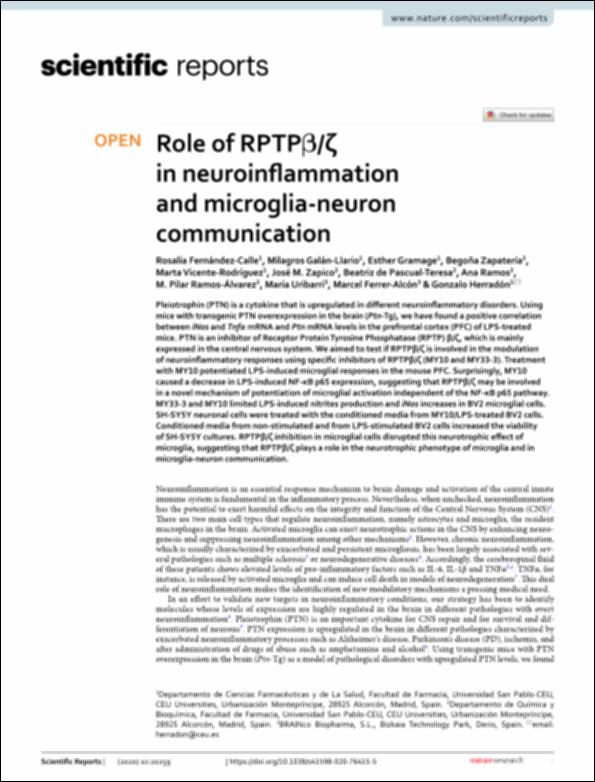Por favor, use este identificador para citar o enlazar este ítem:
http://hdl.handle.net/10637/15217Role of RPTPβ/ζ in neuroinflammation and microglia‑neuron communication
| Título : | Role of RPTPβ/ζ in neuroinflammation and microglia‑neuron communication |
| Autor : | Fernández Calle, Rosalía Galán Llario, Milagros Gramage, Esther Zapatería Gómez, Begoña Vicente Rodríguez, Marta Zapico Rodríguez, José María Pascual-Teresa Fernández, Beatriz de Ramos González, Ana Ramos Álvarez, María del Pilar Ferrer Alcón, Marcel Uribarri, María Herradón Gil-Gallardo, Gonzalo |
| Materias: | Neuroinflammation; Pleiotrophin |
| Editorial : | Nature Research |
| Citación : | Fernández-Calle R, Galán-Llario M, Gramage E, Zapatería B, Vicente-Rodríguez M, Zapico JM, et al. Role of RPTPβ/ζ in neuroinflammation and microglia-neuron communication [Internet]. Vol. 10, Scientific Reports. 2020. |
| Resumen : | Pleiotrophin (PTN) is a cytokine that is upregulated in different neuroinflammatory disorders. Using mice with transgenic PTN overexpression in the brain (Ptn-Tg), we have found a positive correlation between iNos and Tnfα mRNA and Ptn mRNA levels in the prefrontal cortex (PFC) of LPS-treated mice. PTN is an inhibitor of Receptor Protein Tyrosine Phosphatase (RPTP) β/ζ, which is mainly expressed in the central nervous system. We aimed to test if RPTPβ/ζ is involved in the modulation of neuroinflammatory responses using specific inhibitors of RPTPβ/ζ (MY10 and MY33-3). Treatment with MY10 potentiated LPS-induced microglial responses in the mouse PFC. Surprisingly, MY10 caused a decrease in LPS-induced NF-κB p65 expression, suggesting that RPTPβ/ζ may be involved in a novel mechanism of potentiation of microglial activation independent of the NF-κB p65 pathway. MY33-3 and MY10 limited LPS-induced nitrites production and iNos increases in BV2 microglial cells. SH-SY5Y neuronal cells were treated with the conditioned media from MY10/LPS-treated BV2 cells. Conditioned media from non-stimulated and from LPS-stimulated BV2 cells increased the viability of SH-SY5Y cultures. RPTPβ/ζ inhibition in microglial cells disrupted this neurotrophic effect of microglia, suggesting that RPTPβ/ζ plays a role in the neurotrophic phenotype of microglia and in microglia-neuron communication. |
| URI : | http://hdl.handle.net/10637/15217 |
| Derechos: | http://creativecommons.org/licenses/by/4.0/deed.es OpenAccess |
| ISSN : | 2045-2322 |
| Fecha de publicación : | 20-nov-2020 |
| Centro : | Universidad San Pablo-CEU |
| Aparece en las colecciones: | Facultad de Farmacia |
Los ítems de DSpace están protegidos por copyright, con todos los derechos reservados, a menos que se indique lo contrario.


